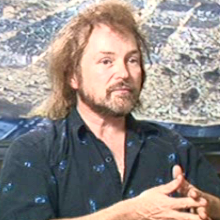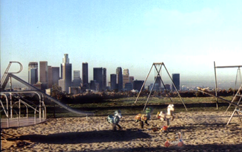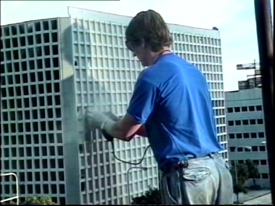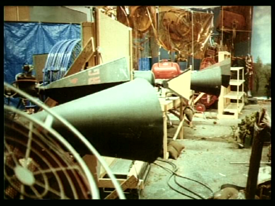
|
Some of the biggest explosion known to man are those created by nuclear bombs. The nuclear bomb was used to great effect in the movie "Terminator 2". In the scene titled "Nuclear Nightmare", we witness through Sarah Connor's dream the destruction caused by a nuclear bomb as it explodes over Los Angeles. The task of creating this incredibly realistic scene was given to a company called 4-Ward Productions. The major driving force behind the project was two brothers (Robert and Dennis Skotak) who worked for 4-Ward. Their skill and experience in creating this scene would later be rewarded when Robert Skotak received an Oscar for best visual effects.
|
The "Nuclear Nightmare" Scene |
||||||
|
Making the Scene |
|||||||
|
The production of the sequence was very complex and involved many different techniques. Most of the individual shots that made up the sequence were not done using computer animation, although a lot of the computer animation techniques that were used are now fairly common in most compositing applications used today. |
|||||||
|
The Initial Blast The effect for the mushroom cloud was created using an unusual technique. No computer animation was used, instead a 9 foot high construction was built that consisted of backlit clears discs and columns. The discs and columns were covered in Dacron fiberfill to give a cloudy/smokey look. The whole structure was mechanised and could grow in height and as it grew the discs would rotate giving the impression of swirling smoke. The final shot was filmed in VistaVision and then layered in behind the city background plate. |
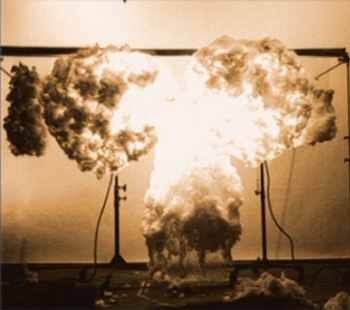
Mushroom Cloud Construction |
||||||
|
To give the effect of the bright light from the blast, two backplates of the city were used. One shot was taken in the morning, and one in the afternoon, when the sun was at its brightest. The contrast of the two shots would be used to emphasize the flash from the nuclear explosion. |
|||||||
|
|||||||
|
The Shockwave One of the main challenges of the nuclear nightmare sequence was showing the blast shockwave travelling across the Los Angeles cityscape. After coming up with several ways of producing the shot, they decided to approach a company called Electric Image who were working on an animation package at the time. Used in conjunction with a plug-in called Mr Nitro, Electric Image were able to produce various sequences of a city being destroyed. The Mr.Nitro plug-in is tool that can destroy geometry based on user defined parameters. As well as breaking up geometry into smaller fragments, the tool also enables forces to be applied so that the fragments look like they are the result of a blast. |
|||||||
| |||||||
|
Destroying Los Angeles ended up being a fairly time consuming and complex process. Firstly, a high resolution photograph of Los Angeles was used as the main matte painting for the sequence. |
|||||||
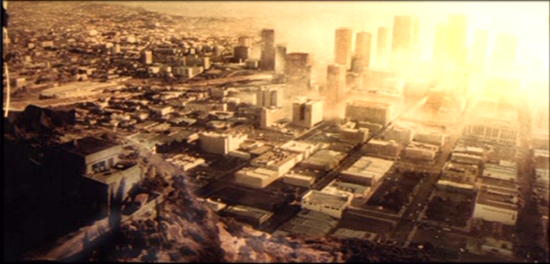
Los Angeles Matte Painting |
|||||||
|
Using the same aspect as the main matte painting of Los Angeles, another matte was produced showing the aftermath of the destruction. |
|||||||
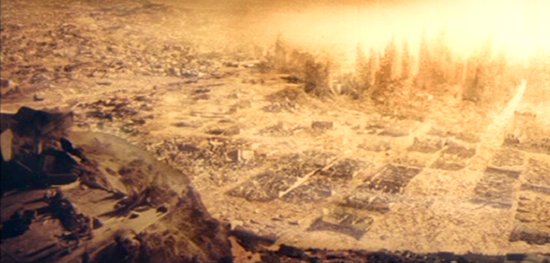
Destroyed Los Angeles Matte Painting |
|||||||
|
For the Mr.Nitro sequence to look convincing, the geometry and layout of the city needed to be recreated. This was done by feeding in road maps and database information from the city planners. This information gave all the required dimensions and locations of the building in Los Angeles. |
|||||||
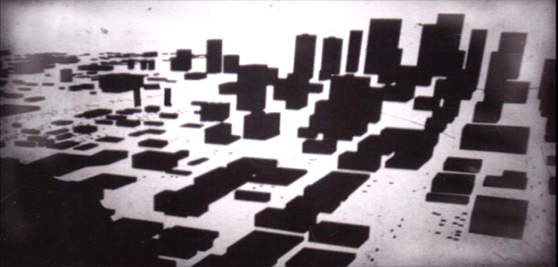
Constructed Geometry of Los Angeles |
|||||||
|
Once all the different shot elements were rendered, they were then transferred back on 35mm film. They were then layered over the top of the original city matte painting. The actual shots were projected onto a screen where a physical device was used to wipe out the instact city and replace it with the destroyed one. |
|||||||
|
Basic Demonstration of Transition |
|||||||
|
|||||||
|
|||||||
